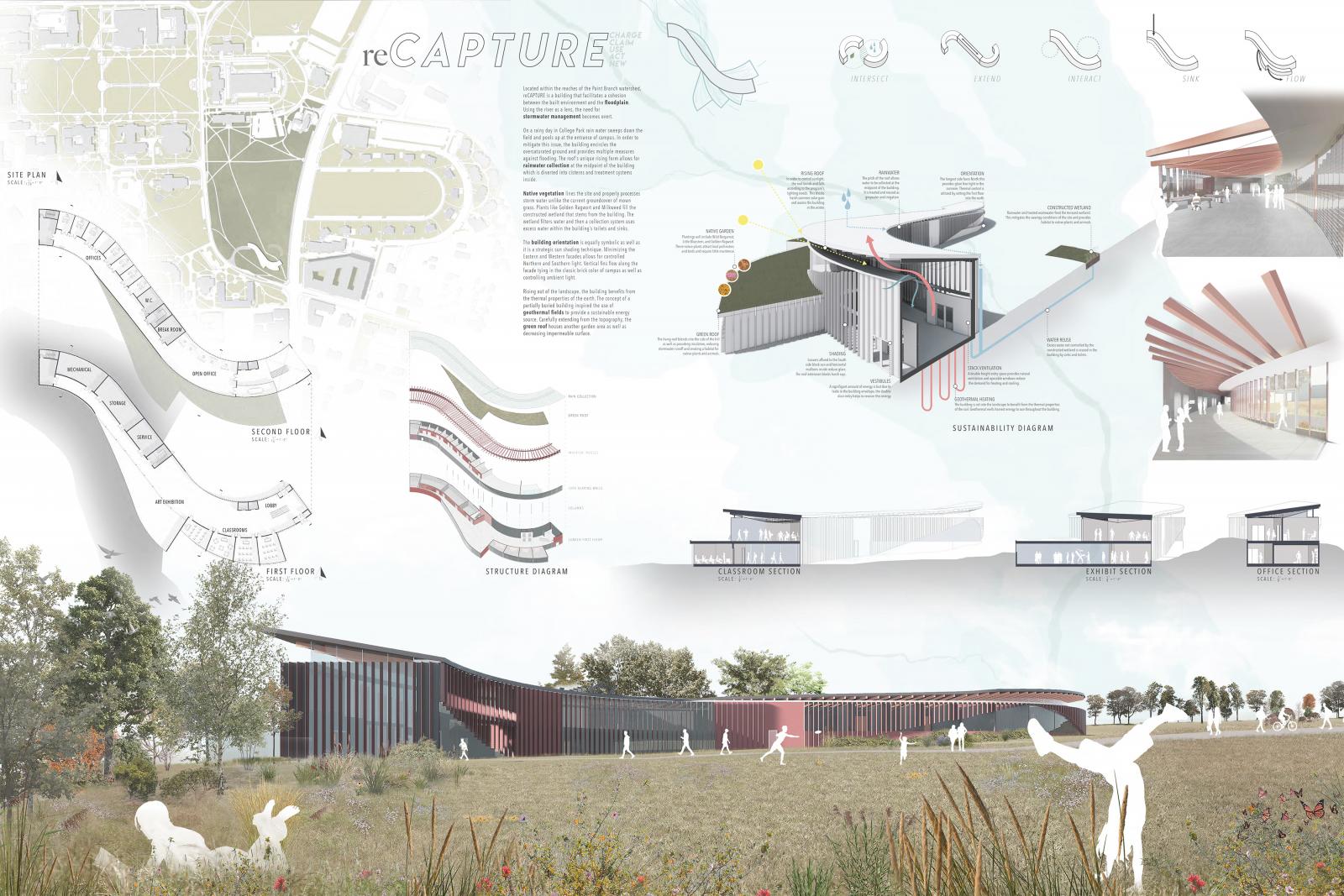Inspiration struck Alex Hall the moment her sneaker sunk into the project site, a spongy green field at the corner of Regents Drive and Route 1: water. “I live across the street from the site and it is always muddy,” said Hall. “The day I visited to take site pictures it was pouring rain and the water was just everywhere, so that was the main thing in my head.” Fittingly, Hall was designing a new sustainability center for the University of Maryland, an exercise that was part final project, part juried competition for ARCH 403: Architecture Design Studio IV. Her design, a sleek, curvy building that meanders through the sloped landscape like a babbling brook, took top honors in the studio’s design competition this month, one of 12 finalists chosen from a pool of 55 undergraduate projects. “It has a movement and a flow and it’s playful,” said Hall. “That’s the best part about architecture school—that you can experiment with crazy ideas like this and see what sticks.”
ARCH 403 is a senior studio course that challenges students to think holistically about the interplay of built and natural environments, while considering opportunities and constraints found within the landscape, the historical context of the site and project, the environment and the building requirements.
“Throughout the studio we asked the students to consider the implications of sustainability starting with the conceptual design of the building,” said Lecturer Brittany Williams, who coordinated the studio and was joined by fellow architects Rayya Newman, Marcus Cross, Josh Hill, and Eric Hurtt. “The idea was to encourage students to integrate strategies related to environmental stewardship into the design process at all scales and not just by adding some solar panels to the roof at the end. We were very pleased to see so many of them take this idea and really run with it.”
This year’s project was uniquely challenging in its topography and project constraints, tasking students to conceptualize a design that strikes the right balance between a bustling Route 1 and the esteemed brick Georgian buildings of campus. Central to the project objectives is the integration of sustainable strategies and systems that complement the engaging research and practice happening at the university and on display at the center. But notable is the desire to see buildings that respond to the landscape rather than merely coexist, where recycled concrete and glass marry with water and soil in cohesive and inviting ways.
“I taught this course for many years, so I know what [they’re] up against,” said Professor Emeritus and jurist Roger Lewis, FAIA. “It’s a little bit like juggling chainsaws while they’re running. There are a lot of variables and a tremendous number of issues to consider. Hats off to the students, who pulled off some really great designs in a short amount of time.”
Lewis was joined by architects Julie Siple, AIA, LEED AP, director of sustainable design and a senior associate at Quinn Evans and Amy Upton (B.S. Architecture, ’98), AIA, LEED Fellow, director of environmental design and a principal at Grimm + Parker, to evaluate the projects at semester’s end and ultimately recognize the stand-outs: Hall’s first place win, along with two second place winners and two honorable mentions.
Projects included Ripple, which took honorable mention, a sleek circular structure featuring 3D-printed concrete, rainwater collection and a green roof. Senior Ryan Muir integrated metals—like brass and copper—into Ripple, materials he felt would add both aesthetic and function to the design. “The biggest challenge was integrating all of the sustainable elements to make a building that would essentially run on its own,” he said. Other designs creatively utilized daylighting, employed voltaic panels or took advantage of the sloped landscape, nestling structures into the campus hillside.
“Everything in this room is really eye candy for us,” said Siple. “The graphics are beautiful and the renderings are amazing. We recognized and appreciated all the hard work and thought that went into these projects.”
ARCH 403 2019 Winners are:
1st Place ($500) - Alex Hall (reCAPTURE)
2nd Place ($250) - Ben Ripley (Node)
2nd Place ($250) - Maria Farieta (Greenscape)
Honorable Mention - Ryan Muir (Ripple)
Honorable Mention - Dylan Blye (Autonomous UMD)

